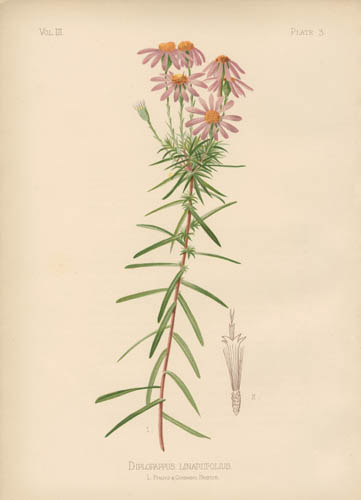Smilax glauca in blossom, running over the shrubbery. Honkenya peploides, sea sandwort, just out of bloom on beach. The thick-leaved and dense tufted, upright plant Salsola Kali, saltwort, prickly and glaucous, in bloom. Beach pea (Lathyrus maritimus) going out of bloom.
The piping plover running and standing on the beach, and a few mackerel gulls skimming over the sea and fishing.
Josh(?) pears (“ juicy,” suggests Small) just begun; few here compared with Provincetown; do not cook them.
Seaside goldenrod (Solidago sempervirens) not nearly yet. Xanthium echinatum, sea cocklebur or sea-burdock, not yet.
What that smilacina-like plant very common in the shrubbery, a foot high, with now green fruit big as peas at end of spike, with reddish streaks? Uncle Sam calls it snake-corn. It is Smilacina racemosa. Brought home some fruit.
Just south of the lighthouse near the bank on a steep hillside, the savory-leaved aster (Diplopappus linariifolius) and mouse-ear (Gnaphalium plantaginifolium) form a dense sward, being short and thick; the aster not yet out.
Scarlet pimpernel, or poor-man’s weather glass (Anagallis arvensis), in bloom some time, very common on sandy fields and sands, and very pretty, with a peculiar scarlet.
H. D. Thoreau, Journal, July 7, 1855
Just south of the lighthouse near the bank on a steep hillside, the savory-leaved aster (Diplopappus linariifolius) . . . not yet out. See July 28, 1853 ("Aster linariifolius."); July 29, 1852 ("That common rigid narrow-leaved faint-purplish aster in dry woods by shrub oak path , Aster linariifolius of Bigelow, but it is not savory leaved. I do not find it in Gray."); August 3, 1858 ("Savory-leaved aster."); August 4, 1851 ("a bluish 'savory-leaved aster.'"); August 16, 1856 (" Diplopappus linariifolius, apparently several days."); September 10, 1854 ("Diplopappus linariifolius and Aster undulatus apparently now in prime."); August 22, 1859 ("The savory-leaved aster (Diplopappus linariifolius) out; how long?"); September 18, 1856 ("Diplopappus linariifolius in prime."); September 29,1853 ("Diplopappus linariifolius, Aster undulatus, and a few small ones"); September 30, 1852 ("We then took the path to Clematis Brook on the north of Mt. Misery, where we found a few of the Diplopappus linariifolius ( savory-leaved aster ) and one or two small white (bushy ?) asters, also A. undulatus"); October 10, 1858 ("Pulling up some Diplopappus linariifolius, now done, I find many bright-purple shoots, a half to three quarters of an inch long, freshly put forth underground and ready to turn upward and form new plants in the spring."); October 12, 1858 ("With man all is uncertainty. He does not confidently look forward to another spring. But examine the root of the savory-leaved aster, and you will find the new shoots, fair purple shoots, which are to curve upward and bear the next year’s flowers, already grown half an inch or more in earth. Nature is confident."); October 16, 1859 ("Many Diplopappus linariifolius are gone to seed, and yellowish globes."); November 7, 1858 ("The Diplopappus linariifolius, which was yellow in the shade, in open and sunny places is purple."); December 26, 1855 (“Weeds in the fields and the wood-paths are the most interesting. Here are asters, savory-leaved, whose flat imbricated calyxes, three quarters of an inch over, are surmounted and inclosed in a perfectly transparent icebutton, like a glass knob, through which you see the reflections of the brown calyx.”)
Sandpaper Star-Wort, or Diplopappus Linariifolius
Ionactis linariifolia —Flax-leaved stiff-aster -- Stiff-leafed Aster, Sandpaper Aster or Sandpaper Starwort (previously classified as Aster linariifolius and Diplopappus linariifolius)
South of the lighthouse
the savory-leaved aster
on a steep hillside.
A Book of the Seasons, by Henry Thoreau, Botanizing Cape Cod.
A Book of the Seasons, by Henry Thoreau
"A book, each page written in its own season,
out-of-doors, in its own locality."
~edited, assembled and rewritten by zphx © 2009-2025
https://tinyurl.com/hdt-18550707





No comments:
Post a Comment